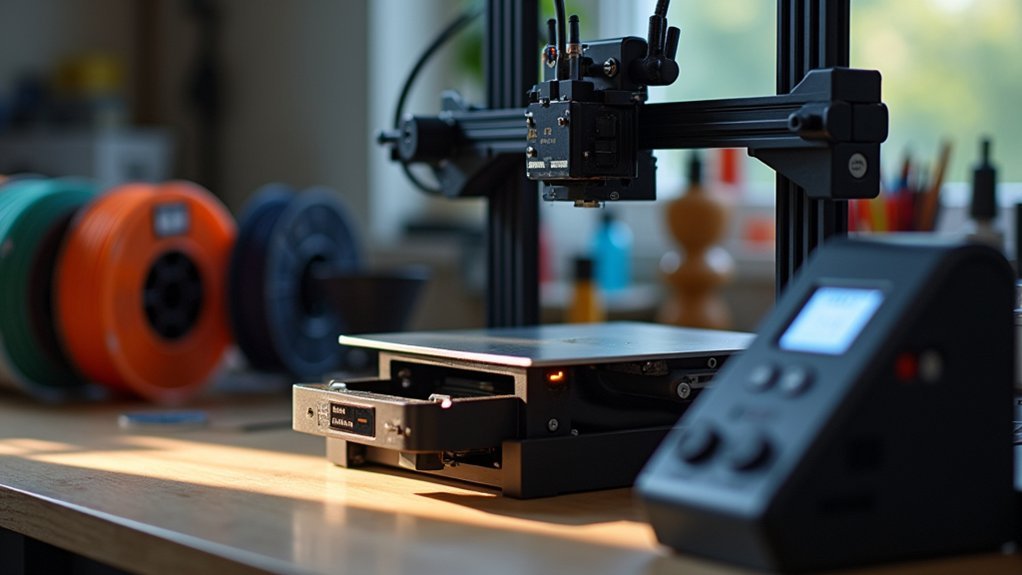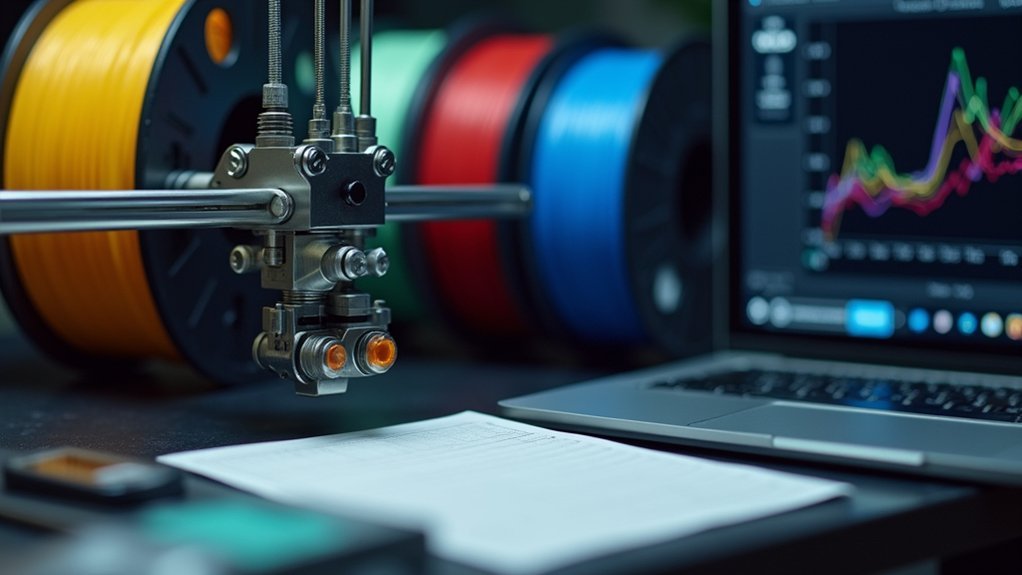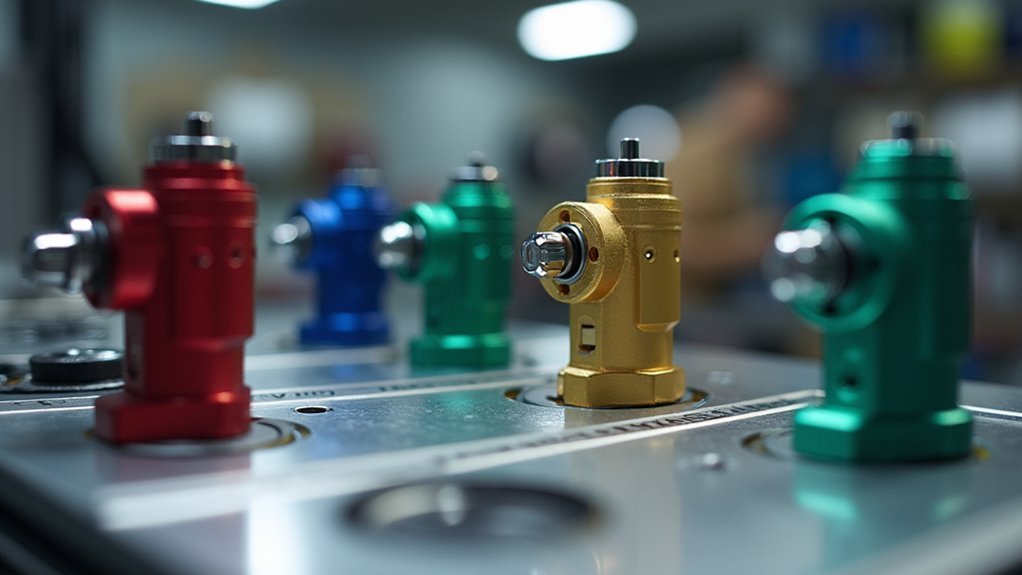You’ll want to start with 2-3mm retraction distance at 50-60mm/s for excellent results with most direct drive extruders. For flexible filaments, reduce to 1-2mm at 30-40mm/s to prevent jams. Standard materials like PLA work well at 4-5mm distances with 40-50mm/s speeds. Don’t exceed 5mm retraction as it won’t improve quality and can cause clogs. Test systematically in 1mm increments to find your printer’s sweet spot for each material type.
Optimal Retraction Length for Direct Drive Systems

When you’re dialing in your direct drive extruder, finding the right retraction length becomes vital for achieving clean prints without excessive stringing.
For most direct drive systems, you’ll want to start with retraction settings between 2-5mm, which provides effective stringing reduction while maintaining reasonable print speeds.
If you’re working with flexible filaments, consider shorter retraction lengths around 1-2mm to prevent jams and guarantee smooth filament movement through your system.
Don’t rely on generic settings—testing is imperative since each printer and filament combination responds differently.
Testing is essential—every printer and filament pairing requires unique calibration for optimal retraction performance.
Avoid excessive retraction lengths that create longer retraction times, potentially causing nozzle clogs from repeatedly emptying and refilling the hotend.
Regular calibration based on your specific materials and environmental conditions will optimize your retraction settings and greatly improve print quality.
Balancing Speed and Distance for Clean Transitions
Because retraction distance and speed work together as interdependent variables, you’ll need to fine-tune both settings simultaneously to achieve the cleanest layer changes in your direct drive system. When you reduce retraction distance, you can increase retraction speed for better results without risking filament damage.
| Distance (mm) | Retraction Speed (mm/s) | Result Quality |
|---|---|---|
| 2-3 | 50-60 | Excellent |
| 3-4 | 40-50 | Good |
| 4-5 | 30-40 | Acceptable |
Start with shorter distances around 2mm and higher speeds near 60mm/s, then adjust based on your specific filament’s behavior. This approach prevents over-retraction while maintaining quick, clean changes between print sections.
Fine-Tuning Settings for Different Filament Types

Different filament materials require distinct retraction approaches since their unique properties—from flexibility to thermal behavior—directly impact how they respond to withdrawal forces.
You’ll need to adjust your printer settings based on specific material characteristics for ideal results.
For flexible filaments, use shorter retraction distances of 1-3 mm to prevent deformation during withdrawal. Set retraction speeds between 30-40 mm/s to avoid filament slippage.
Standard materials like PLA and PETG perform best with 4-6 mm retraction distances and faster retraction speeds of 40-60 mm/s.
Don’t forget to take into account filament temperature and moisture content when fine-tuning your settings.
Regular testing guarantees you’re achieving the cleanest changes possible while minimizing stringing issues across different material types.
Preventing Over-Retraction and Nozzle Clogs
Improper retraction settings create more problems than they solve, particularly when you push distances beyond what your direct drive system actually needs.
Keep your retraction distance between 2-5mm to prevent over-retraction complications. Higher distances don’t improve print quality—they’ll cause nozzle clogs and extend retraction times unnecessarily.
Set your retraction speed between 30-60mm/s for ideal performance. This range prevents filament slippage while maintaining efficient movement.
Don’t forget that different filaments require adjusted parameters, so test settings for each material you use.
Maintain a minimum retraction distance of 0.5-1mm to reduce unnecessary retractions during intricate prints.
Regular nozzle cleaning and proper filament feeding will help you avoid retraction-related issues and maintain consistent extrusion flow throughout your printing sessions.
Testing and Calibrating Your Distance Parameters

While theoretical guidelines provide a starting point, you’ll achieve excellent results by systematically testing your direct drive extruder’s retraction settings with real prints.
Start with 2-5mm retraction distance and 30-60mm/s speed, then conduct trials using 1mm increments to find your best setting.
Begin with 2-5mm retraction distance and 30-60mm/s speed, testing in 1mm increments until you discover optimal settings.
Print retraction towers to visually assess stringing performance across different parameters. Count the rings on your tower to accurately adjust retraction length for your specific filament type.
Monitor fan speed alongside retraction settings, as cooling affects stringing behavior. Test various temperature combinations with your retraction parameters to eliminate clogs while maintaining good results.
Close observation during calibration guarantees you’ll identify the perfect balance between preventing stringing and avoiding over-retraction issues.
Frequently Asked Questions
What Is the Best Retraction Distance for Direct Drive?
You’ll want to use 2-5mm retraction distance for most filaments. For flexible materials, stick closer to 1-2mm to prevent jamming. Always test and adjust based on your specific filament’s behavior.
What Happens if Retraction Distance Is Too High?
You’ll experience longer print times, potential hotend clogs from cooled filament, increased filament wear and breakage, pressure buildup causing inconsistent extrusion, and ironically more stringing when printing resumes.
What Is the Retraction Distance for TPU Direct Drive?
You’ll want to set your retraction distance between 1-3mm for TPU on direct drive extruders. Start with 2mm and adjust based on stringing results, keeping it minimal to prevent jams.
What Are the Direct Drive Settings for PLA?
You’ll want to set your retraction distance between 1-2mm and speed at 30-45mm/s. Keep your printing temperature between 190-220°C and regularly clean your nozzle for best results.





Leave a Reply